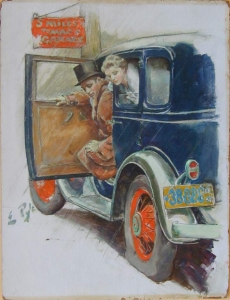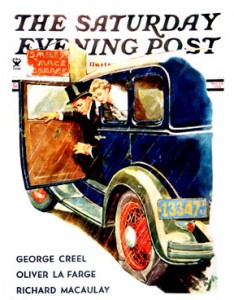
Ellen B. T. Pyle (1876-1936)|Flat Tire, Flat Evening|Study for cover for The Saturday Evening Post (November 24, 1934)|Oil on board|Private collection|© 1934 SEPS: Licensed by Curtis Publishing, Indianapolis, IN
 In 1919 Ellen Bernard Thompson Pyle’s husband of fifteen years passed away. Left with four children under the age of thirteen and a mortgage, Ellen Pyle decided to return to illustrating in order to support her family. In the 1890s she had been an art student at the Drexel Institute (the precursor to Drexel University) in Philadelphia and studied illustration with Howard Pyle.
In 1919 Ellen Bernard Thompson Pyle’s husband of fifteen years passed away. Left with four children under the age of thirteen and a mortgage, Ellen Pyle decided to return to illustrating in order to support her family. In the 1890s she had been an art student at the Drexel Institute (the precursor to Drexel University) in Philadelphia and studied illustration with Howard Pyle.
As one Howard Pyle’s better students, Ellen Bernard Thompson was assigned to various paying assignments provided to those whose work was exceptional. Along with other students and Howard Pyle, she worked to produce illustrations for the serially published Revolutionary War story “Janice Meredith” in Collier’s Weekly and later in the 1900 publication of Hawthorne’s Complete Works. After her marriage to Howard Pyle’s brother Walter, Ellen Pyle concentrated on her family and put away her illustration work.
With the help of her sister-in-law, the illustrator and author Katharine Pyle, Ellen made her way back into the working world landing her first Saturday Evening Post cover in 1922. For these covers and her other illustration commissions Ellen Pyle often used her own children as models, sometimes changing their appearance slightly making them older looking or more sultry in the case of her daughters.
As her children aged, so too did some of the illustration images she constructed. To produce images of younger children, Ellen Pyle employed various children from the Wilmington, Delaware community. In the 1930s her children began to marry and since these marriages brought new faces into the family circle, they too were conscripted into serving as models. Ellen Pyle did not necessarily pair these new models with their spouses. Usually Ellen Pyle’s Saturday Evening Post cover illustrations are straight forward images of daily life activities. In this case, Pyle created a humorous vignette of dating difficulty called Flat Tire, Flat Evening, with her daughter Katharine’s husband Frederick H. Smith posed with his sister-in-law Ellen Pyle Lawrence partially disguised in a blonde wig.
What is most interesting is the comparison of the study for this illustration to the finished work for this 1934 Saturday Evening Post cover. Notice the change in license plate number from the blue on yellow number 38-866, to the more clearly read yellow on blue number 13347. The young man who in the study wears a brown wool top coat that is transformed and up scaled for the Post cover into a dressier black topcoat. The visible wheel hub is green in the study and silvery chrome in the cover picture, while the reflective rear light attached above the license plate in the study is smaller and placed below the license plate in the cover image. And finally, Ellen Pyle’s signature was adjusted from under the front left car wheel to underneath the car’s rear bumper which itself was modified in the finished work.
The Delaware Art Museum will be hosting the first retrospective exhibition of Ellen Pyle’s work, called Illustrating Her World: Ellen B. T. Pyle, from August 1, 2009 through January 3, 2010.
July 23, 2009
By Joyce K. Schiller, Curator, Rockwell Center for American Visual Studies
Norman Rockwell Museum






